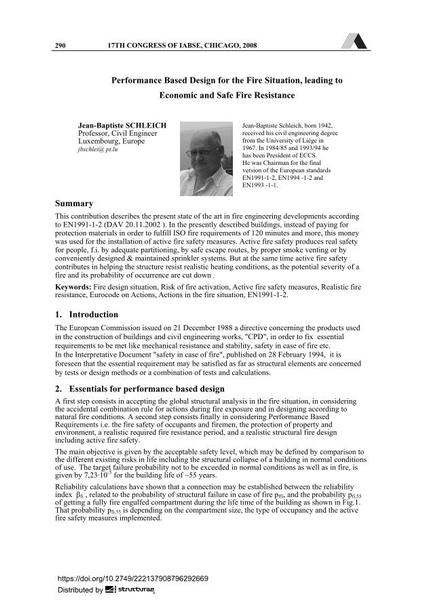Performance Based Design for the Fire Situation, leading to Economic and Safe Fire Resistance

|
|
|||||||||||
Bibliographic Details
| Author(s): |
Jean-Baptiste Schleich
|
||||
|---|---|---|---|---|---|
| Medium: | conference paper | ||||
| Language(s): | English | ||||
| Conference: | 17th IABSE Congress: Creating and Renewing Urban Structures – Tall Buildings, Bridges and Infrastructure, Chicago, USA, 17-19 September 2008 | ||||
| Published in: | IABSE Congress Chicago 2008 | ||||
|
|||||
| Page(s): | 290-291 | ||||
| Total no. of pages: | 8 | ||||
| Year: | 2008 | ||||
| DOI: | 10.2749/222137908796292669 | ||||
| Abstract: |
Jean-Baptiste Schleich, born 1942, received his civil engineering degree from the University of Liège in 1967. In 1984/85 and 1993/94 he has been President of ECCS. He was Chairman for the final version of the European standards EN1991-1-2, EN1994 -1-2 and EN1993 -1-1. This contribution describes the present state of the art in fire engineering developments according to EN1991-1-2 (DAV 20.11.2002 ). In the presently described buildings, instead of paying for protection materials in order to fulfill ISO fire requirements of 120 minutes and more, this money was used for the installation of active fire safety measures. Active fire safety produces real safety for people, f.i. by adequate partitioning, by safe escape routes, by proper smoke venting or by conveniently designed & maintained sprinkler systems. But at the same time active fire safety contributes in helping the structure resist realistic heating conditions, as the potential severity of a fire and its probability of occurrence are cut down . |
||||
| Keywords: |
Fire design situation Risk of fire activation active fire safety measures Realistic fire resistance Eurocode on Actions actions in fire situations EN1991-1-2
|
||||
